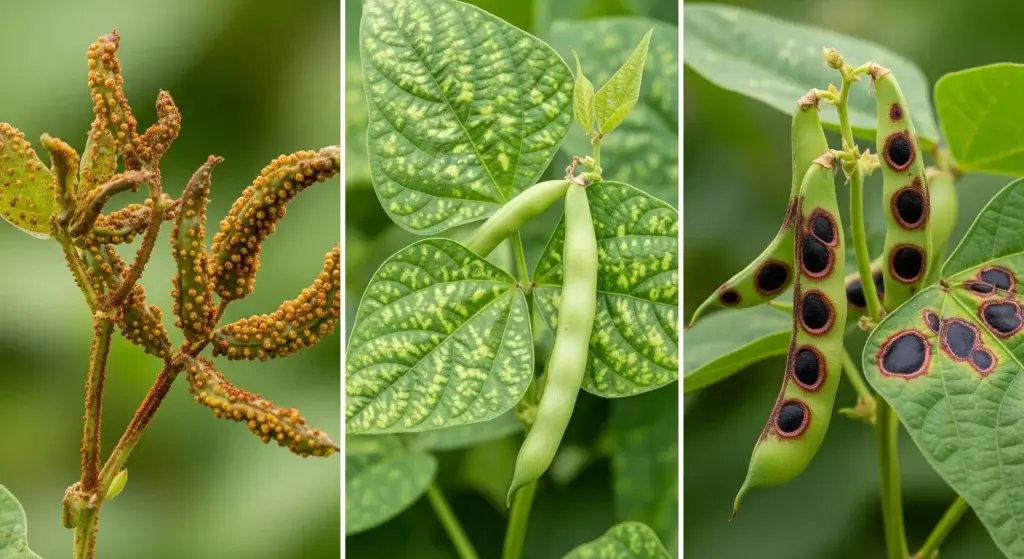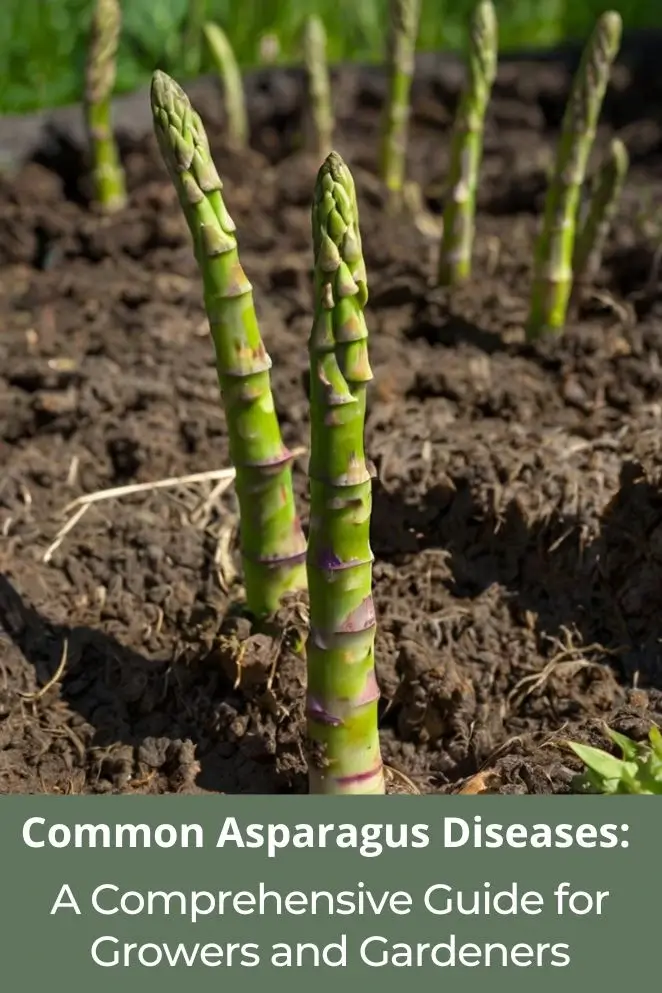
Asparagus can keep producing for decades—but only if you keep it healthy.
Like any crop, it’s vulnerable to disease, which can mess with your harvest and shorten its lifespan.
This guide breaks down the most common asparagus diseases, what causes them, what they look like, and how to deal with them.
Whether you grow for fun or for profit, knowing this stuff helps you keep your asparagus patch strong for the long haul.
Why Asparagus Disease Management Matters
Asparagus isn’t a one-season crop—it’s a long game.
A well-managed bed can pump out spears for 15–20 years.
But if disease hits, you could lose yield, quality, or even the whole patch.
The biggest threat? Fusarium crown and root rot—hands down the most damaging asparagus disease worldwide.
If you ignore early signs, you risk replanting years too soon.
Spot problems early, manage them right, and you’ll keep your asparagus investment growing strong.
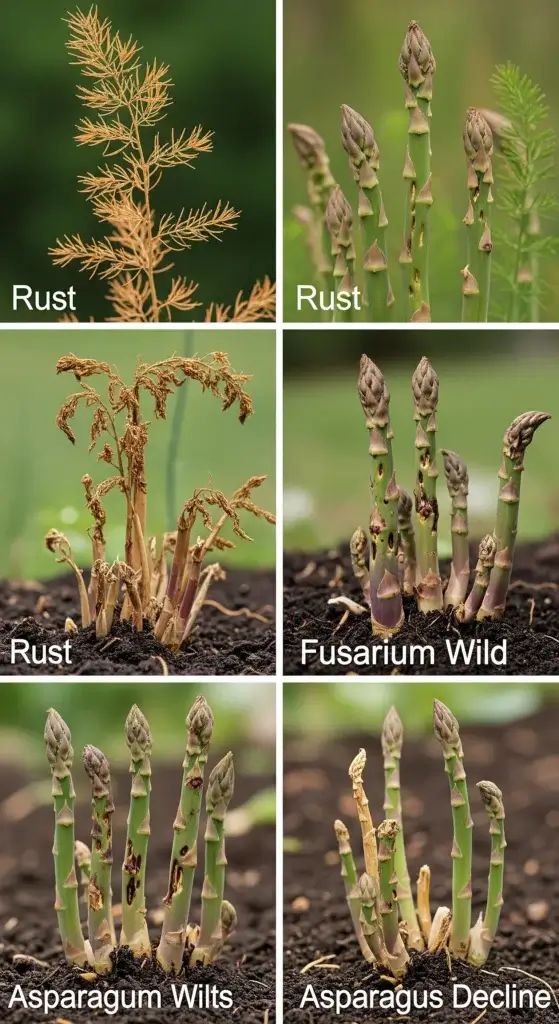
Major Fungal Diseases of Asparagus
If you’re growing asparagus long-term, you’ve gotta keep an eye out for fungal diseases.
They creep in slowly, mess with your plants, and can kill entire beds if you ignore them.
Here’s a plain-talk breakdown of the biggest troublemakers and what to do about them.
1. Fusarium crown and root rot
The big bad fungus
This is the #1 disease asparagus growers deal with worldwide.
Two fungi—Fusarium oxysporum f.sp. asparagi and Fusarium proliferatum—cause it.
They hang out in the soil forever and can even hitch a ride on seeds.
What it looks like:
- Spears come up shriveled or rot before you even see them
- Ferns grow short and turn yellow or brown
- Crowns rot but stay dry inside
- Plants slowly lose energy and die over time
- Usually starts in patches, then spreads
How to handle it:
- Pick spots with good drainage
- Don’t plant where asparagus died before
- Use Fusarium-resistant varieties if you can get them
- Add compost or organic matter to boost soil health
- Rotate crops—don’t replant asparagus in the same bed right away
- Rip out and trash infected plants (don’t compost them)
2. Asparagus rust
The sneaky summer problem
This one’s caused by Puccinia asparagi and shows up mostly during warm, humid weather.
The worst part? It can evolve and beat plant resistance over time.
What it looks like:
- Orange-red bumps (pustules) on stems and ferns
- Leaves turn yellow and fall off early
- Plants get weak and stop growing properly
- You’ll see rust-colored spores if you look close
How to handle it:
- Spray preventive fungicides when the weather’s warm and wet
- Plant rust-resistant varieties—but know they might not stay resistant forever
- Clean up and toss out infected fern debris in the fall
- Space your plants so air can move through the bed
3. Purple spot disease
Looks harmless, ruins your harvest
This shows up during harvest and makes spears ugly—bad news if you’re selling or just like nice-looking food.
Caused by Stemphylium vesicarium.
What it looks like:
- Dark purple or black spots on spears and ferns
- Lower parts of the plant get hit first, then it spreads upward
- Infected spears aren’t marketable
- Shows up most when it’s warm and humid
How to handle it:
- Check your field weekly during growing season
- Spray fungicides when the weather favors disease
- Pick and trash any infected spears
- Keep plants well-fed and avoid overhead watering
4. Cercospora blight
Looks like rust but isn’t
Caused by Cercospora asparagi, this one can show up with purple spot and rust.
It targets foliage and weakens the plant over time.
What it looks like:
- Gray or tan spots on ferns, usually with a reddish edge
- Leaves turn yellow from far away
- Lesions are oval or round, and sunken
- If you look closely, you’ll see tiny spores inside the spots
How to handle it:
- Stick to a fungicide schedule, especially if your area’s humid
- Keep plants healthy with regular feeding and watering
- Remove infected debris so it doesn’t spread
- Watch the weather and act early when conditions are right for disease
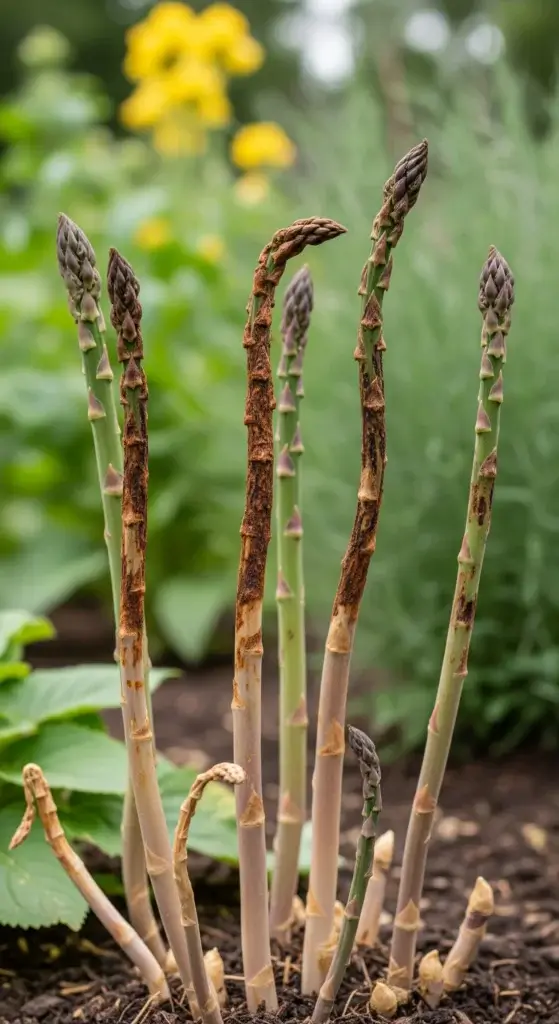
Viral Diseases Affecting Asparagus
Asparagus isn’t just dealing with fungus—viruses can mess it up too.
So far, scientists have found nine viruses that affect asparagus.
Three of them—Asparagus virus 1 (AV1), AV2, and AV3—only infect asparagus.
Others like Tobacco mosaic virus (TMV), Cucumber mosaic virus (CMV), and Tobacco streak virus (TSV) can tag along too.
What viral infection looks like
- Mosaic leaves – Weird light and dark green patches
- Stunted growth – Plants look small and sad
- Wonky shapes – Leaves and stems grow all funky
- Lower yield – Fewer spears, and not the good kind
How to handle it
Viruses don’t go away once they’re in.
So your best move is stopping them from showing up in the first place.
- Fight the bugs – Especially aphids, which spread most viruses
- Start clean – Only plant virus-free crowns or seeds
- Kill the weeds – Some weeds carry viruses, so don’t let them hang out near your asparagus
- Wipe your tools – Don’t spread viruses with dirty clippers
Environmental and Cultural Disease Factors
Fungus isn’t always the main villain—sometimes bad soil and stress open the door.
Here’s how the growing environment affects asparagus and what you can do about it.
Soil can help or hurt
Bad soil = sick plants.
Things like poor drainage, hard-packed ground, or missing nutrients make asparagus way more likely to get crown and root rot.
What asparagus likes:
- Good drainage – Water should flow, not sit
- Balanced pH – Aim for 6.5 to 7.5
- Plenty of organic matter – Add compost to keep soil loose and full of life
- Right nutrients – Test your soil and feed accordingly
Stress makes disease worse
Any stress—drought, weeds, weird weather—makes asparagus more vulnerable.
Fusarium especially loves stressed-out plants.
Common stress triggers:
- Too dry or too wet – Both can mess up roots
- Extreme temps – Heat waves or cold snaps weaken defenses
- Damage during harvest – Wounds = open doors for fungus
- Weeds – They steal water and nutrients, making plants weaker
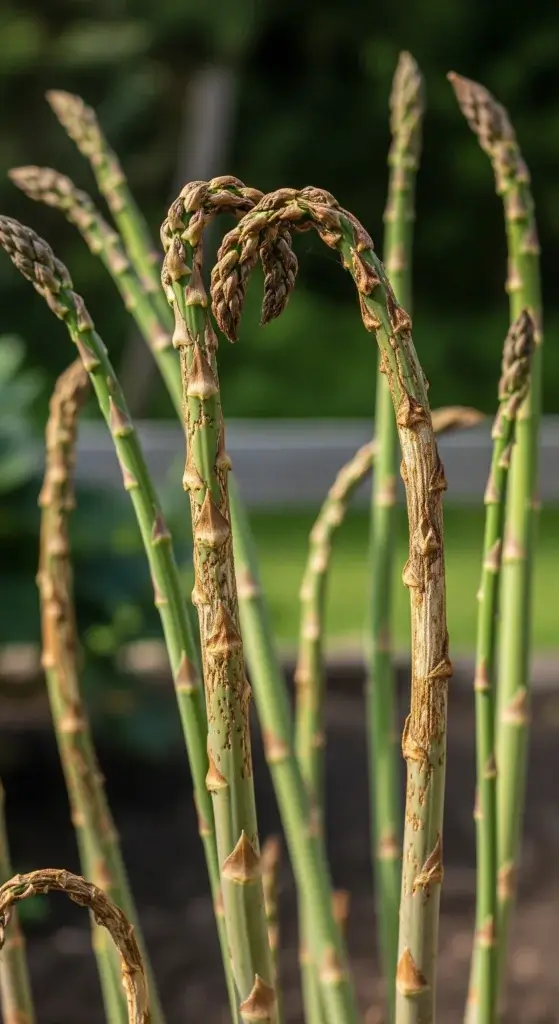
Integrated Disease Management Strategies
Fighting disease in asparagus isn’t about playing catch-up—it’s about staying ahead.
The best strategy? Prevent problems before they show up.
Here’s how to do that like a pro grower.
Start with prevention
Treating disease is expensive and messy.
Preventing it is smarter and cheaper.
Site Prep Comes First
- Pick a good spot – Choose a field with solid drainage and airflow
- Test your soil – Check pH, nutrients, and any disease risk
- Fix it before planting – Add compost or minerals to balance it out
Pick the right varieties
- Use disease-resistant types – Choose ones that stand up to local issues
- Look for multiple resistances – Some varieties fight off more than one disease
- Stay updated – New resistant varieties drop every few years—keep an eye out
Use smart growing habits
- Space your plants right – Crowded plants = poor airflow = fungal party
- Irrigate the right way – No overhead sprinklers; drip systems work best
- Feed your plants – Keep soil nutrition steady through the season
Watch your field like a hawk
Catching issues early makes a huge difference.
Don’t wait for things to look bad.
Scout weekly
- Check regularly – Walk your field at least once a week
- Be consistent – Use the same path and method each time
- Write stuff down – Log what you see: which plants, how bad, and what the weather’s like
- Double-check ID – Not sure what it is? Ask your local extension office or send samples to a plant lab
When to watch closest
- Spring emergence – Look for weird or rotting spears
- Fern growth phase – That’s when leaf diseases show up
- Harvest – Look for spots, mush, or off-color spears
- After harvest – Check if plants are declining more than usual
When you need to treat
Sometimes even good prep isn’t enough. That’s when it’s time to hit back—with care.
Fungicides
- Only use ones labeled for asparagus – Read the label, don’t wing it
- Time it right – Spray before or right as disease appears
- Rotate products – Don’t use the same type over and over, or you’ll build resistance
- Go organic if needed – Some fungicides are approved for organic growers
Biological tools
- Try helpful microbes – Some can block or outcompete disease in the soil
- Compost teas – Spray or drench with them to boost microbe activity
- Use with other methods – Biocontrols work best when part of a full plan, not a solo act
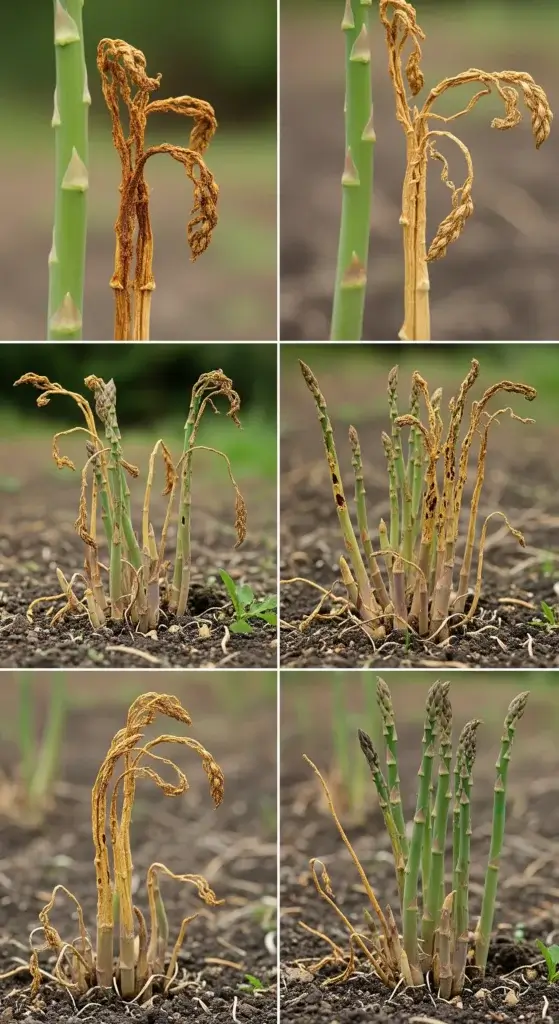
Final Take: Keep Your Asparagus Alive and Thriving
Asparagus can grow strong for 15–20 years—but only if you stay on top of disease.
The trick? Don’t wait for problems.
Prep your site, pick resistant varieties, scout often, and treat early when needed.
Mix smart growing habits with good tools, and you’ll get consistent, quality harvests year after year.
Stay curious, keep learning, and ask for expert help when things get weird.
Long story short: treat your asparagus like a long-term relationship—it needs regular attention, but it’s totally worth it.



